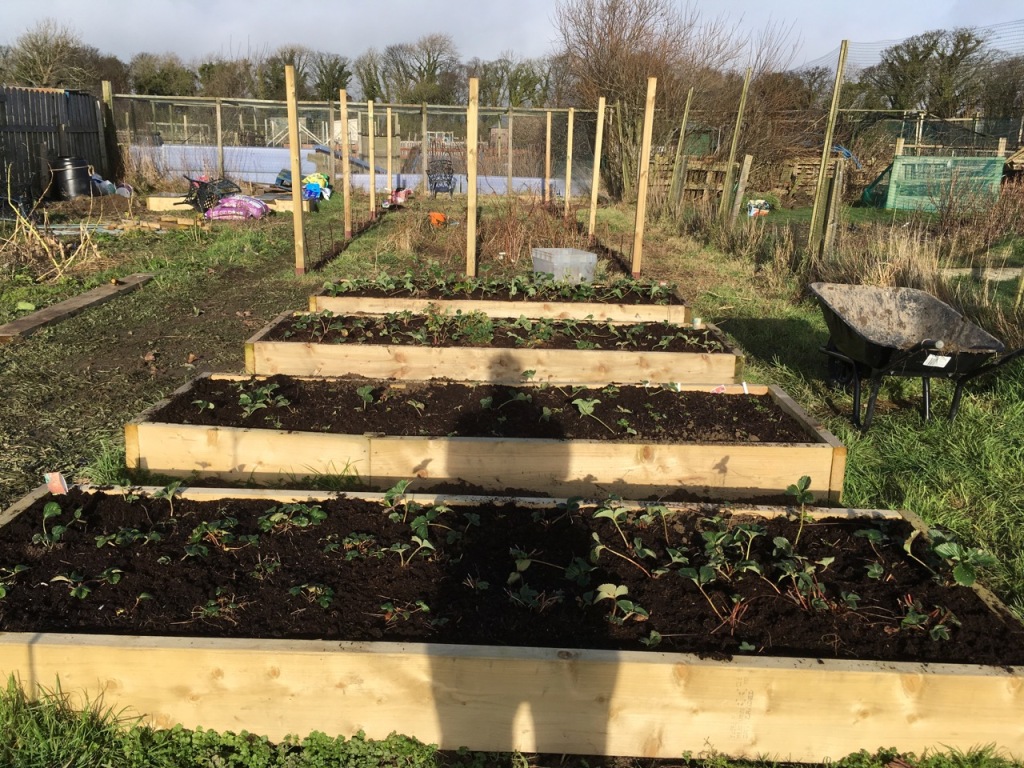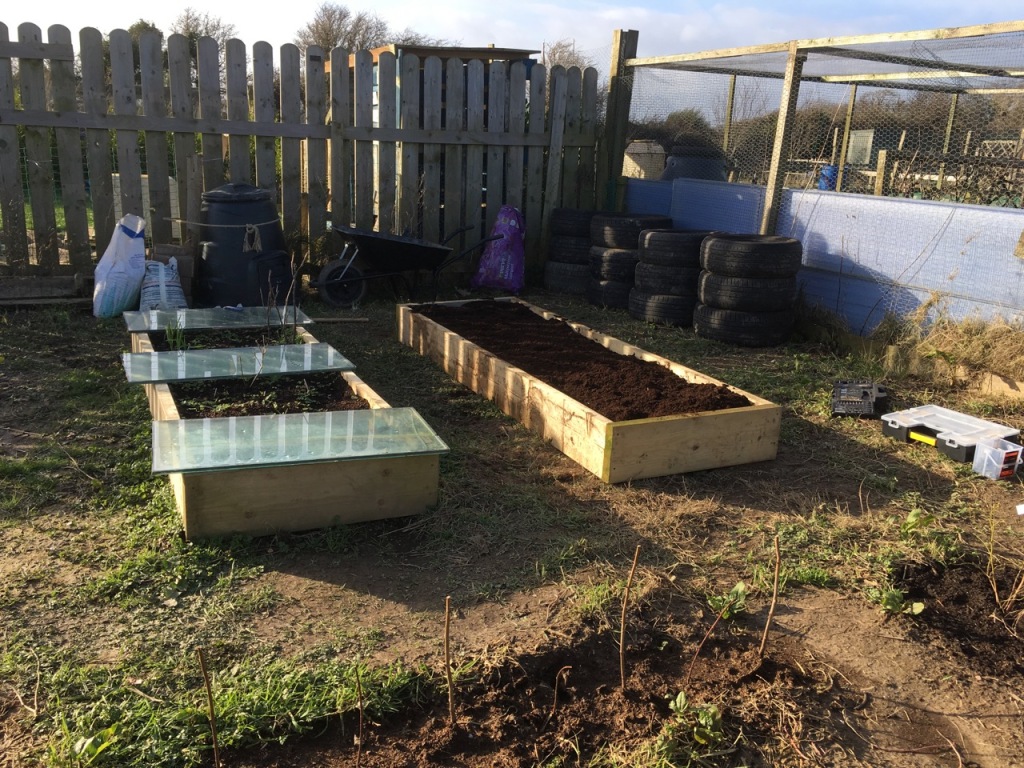Those of you who have been following this blog will know that I acquired an allotment this time last year – a 30×100 foot plot of land rented from a local farmer for the purpose of growing fruit, vegetables and flowers. You will also know that one reason I decided to do this – apart from the fact that it’s enjoyable for its own sake – is because I can foresee food shortages in the years ahead, so learning how to grow your own food is a sort of insurance policy. So I’m trying to prove to myself and my family that it is possible to grow a significant proportion of your own food yourself. Or maybe I’ll prove that it’s not possible, depending on how things work out.
If you are going to try growing food, now is the time to start, because you are going to make lots of mistakes to begin with, and it’s better to get your mistakes out of the way while they don’t matter than to depend on a food crop for survival and then have it fail because of something simple you did wrong. I made a ton of mistakes in my first year, and I’m going to list some of them here, but rest assured, you will make lots of completely new mistakes of your own which I haven’t even thought of. It’s a good idea, at the end of each season, to make a note of what grew well, what grew poorly, what mistakes you made and what you could have done differently. Fortunately Mother Nature is forgiving (up to a point, provided you don’t take her too much for granted) and every Spring you get the chance to start afresh and do better this year.
My biggest mistake last year was failing to get the balance right between planting and aftercare (mainly watering and weeding) with the result that at least 50% of my effort was wasted. 30×100 feet is a large plot to cultivate if you’re not used to it and I was rather over-ambitious, using a mechanical rotovator to prepare the ground over the entire plot and then planting row after row of vegetables. However, while I was planting halfway along the plot, the weeds were already smothering the crops I had planted at the top end, and by the time I finished planting at the bottom end, some of the crops I had planted half way along had died from dehydration because I was too busy planting new crops to water them.
So you have to tailor your activities to the size of the plot and how much time, realistically, you are able to spend on it. In my case, the demands of work and family mean that I can spend at most half a day a week tending it. So this year I’ve planted half the plot with low-maintenance permanent plants – fruit trees, strawberries, raspberries and other soft fruits – and I’ve left room between them to get an electric lawnmower in to deal with the weeds. One quarter of the plot is used for storage – large shed for garden tools, small shed for the lawnmower, hard area for hosepipes, watering cans, large pieces of wood and glass and other bulky things which can be kept in the open, and the all important compost heap – so I’m only doing intensive vegetable cultivation on the remaining quarter of the plot.
Here is a plan of my allotment at the start of this season:

And here is a photo of the soft fruit area:

I have reserved a small area for “herbs and other delicate or experimental plants”. I’m not going to say too much about this now, because it’s probably going to form the subject of a future blog post or even a book, but I’m interested in herbal medicine and I’m planning to grow a number of unusual, not to mention toxic, medicinal plants. I’ve positioned this area at the far end of the allotment, furthest away from the gate and curious eyes and hands. Mandrakes, for example, have long tap roots and don’t like being too cold or wet, so I’ve set up some stacks of old tyres to grow them in, which will give them fairly warm dry soil and plenty of space below ground:

A friend delivered a big pile of farmyard manure for me which I’m gradually working into the plot:

Our resident tame robin, which shows up as soon as I start digging in order to look for worms, and which has absolutely no fear of people:

Next up: don’t believe the instructions on seed packets. They are a rough guide only: you have to pay attention to your own soil and climate conditions, do some trial and error and experience a few failures. Case in point: peas. Peas are tricky b******s, although you wouldn’t think it to look at them. “Plant outdoors from January onwards”, it says on the packet, making it sound so easy. Yeah, right. I tried that and most of the seeds rotted – I got about a 5% germination rate. I tried again in seed trays – same thing. So then, after doing some research on the internet, I germinated the peas in a plastic bag in the garage, then planted them in seed trays after they had sprouted. Result: I still only got about a 25% germination rate, but at least I knew which ones had germinated and I was able to plant those.
The basic problem is that I live on the Isle of Man which is on the same latitude as Labrador in northern Canada. It’s considerably warmer than Labrador thanks to the Gulf Stream, but we still only get a short and fairly cool growing season. So although planting seeds outdoors in the middle of winter may be fine in Southern England, it just doesn’t work here, and to maximise the chances of success most seeds needs to be started off indoors, then grown on under glass, and early enough in the growing season so that the plants have time to mature. It also gives them a head start on the weeds and pests.
Some plants I tried to grow last year were a complete bust, producing no ripe fruit at all, particularly tomatoes and peppers, which are basically plants of hot climates. I’m not going to try to grow peppers again, but I have found a variety of cherry tomato which seems to do reasonably well in our climate, so I’m going to try to grow those again and this time protect them with some old panes of glass (which you can see in the herb garden picture) until the weather warms up.
Pest control is something I’m going to pay far more attention to this year. Last year, of the 50% of my crops which survived the drought, weeds and my general inattention, at least half was eaten by pigeons, mice, birds, slugs and snails, and my crop of Brussels sprouts failed completely when it was chewed off at the roots by cabbage root fly. I’m trying to avoid using chemicals on my plot, partly because it’s bad for the environment and partly because I’m trying to simulate growing food in a post-industrial, post-chemical environment. But that does mean that I’m going to have to use lots of mechanical barriers like polytunnels, bird nets, rabbit fencing, mousetraps and slug tape.
Incidentally, the Brussels sprout failure is a reminder to have a mixture of plants, not a monocrop, so that if one plant fails due to adverse pest or climate conditions, hopefully most of the others will thrive. For an example of what not to do, think “Irish potato famine”.
One mistake I nearly made, but caught it just in time, was planting two identical pear trees. Having ordered and planted them, I was reading a gardening book when I found, buried in the small print, advice to plant different varieties of pear tree so they can cross-pollinate each other. Yes, ladies and gentlemen, shocking though this may sound, pear trees have sex with each other when we aren’t looking, but only with a different pear tree, not one of the same kind. If they don’t have sex they don’t produce fruit. So I quickly ordered and planted another two pear trees of different varieties, and now all is well, but that was a near miss. I could have ended up ten years down the line with two mature pear trees producing flowers but no fruit.
And finally, think about where things are best situated so you don’t have to move them around later. To some extent this is inevitable as a garden is always a work in progress, but in the last four months I’ve moved fruit bushes, compost heaps and strawberry beds from where they shouldn’t have been to where they need to be, and I could have saved myself a lot of work. However, I think I’ve got the spacing of the new fruit trees about right.
Slaynt vie, bea veayn, beeal fliugh as baase ayns Mannin
The biggest thing I’ve learned about gardening (in mid-Maryland) is that my greens can freeze solid, and recover, as long as they’re protected from movement while frozen. That means that a well-ventilated cold frame can hold spinach, kale, arugula, parsley, and/or lettuce, as long as it’s not so well ventilated that the wind can knock things around inside. It keeps the snow and ice (as well as wind) from breaking the leaves. Nothing will grow when even the daytime time is below freezing, but sunny days with frosty nights are no problem. A thick layer of leaf mulch might be important to keep the roots from freezing. Leaves that actually touch a frosty window surface will be damaged, but new growth will replace them. Ventilation is important, because temps can otherwise get dangerously high on a sunny winter day.
The biggest mistake I’ve made is not protecting my produce from raids by deer and groundhogs. The only things they’ve ignored are onions, chives, and garlic.